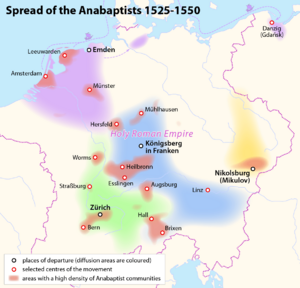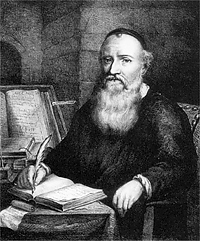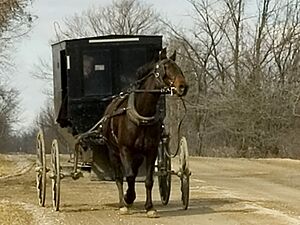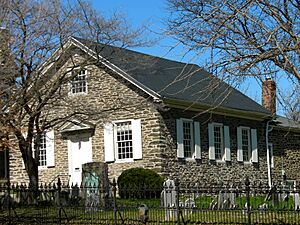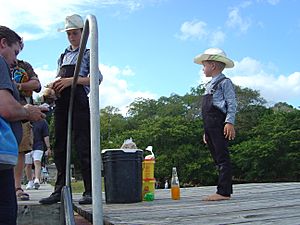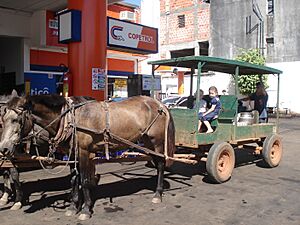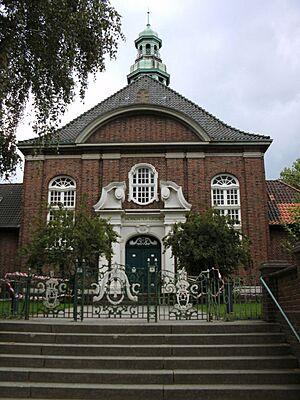Mennonites facts for kids

Emblem of the Mennonite World Conference
|
|
| Total population | |
|---|---|
| Regions with significant populations | |
| United States | 500,469 |
| Ethiopia | 310,912 |
| Dem. Republic of the Congo | 225,581 |
| Bolivia | 150,000 |
| Canada | 149,422 |
| Mexico | 110,000 |
| Indonesia | 102,761 |
| Tanzania | 92,350 |
| Thailand | 63,998 |
| Zimbabwe | 50,287 |
| Germany | 47,492 |
| Paraguay | 36,009 |
| Kenya | 35,575 |
| Angola | 30,555 |
| Religions | |
| Anabaptist | |
| Scriptures | |
| Bible | |
Mennonites are a group of Christian communities. They are part of a larger movement called Anabaptism. Their story began during a time of big changes in religion, known as the Radical Reformation. The name "Mennonites" comes from a leader named Menno Simons (1496–1561). He lived in a region that is now part of the Netherlands.
Menno Simons helped shape the beliefs of the Anabaptist movement. He wrote about their ideas, which were based on the teachings of Jesus. These beliefs were written down in the Dordrecht Confession of Faith in 1632. Key ideas include only baptizing believers (not babies), showing humility, living simply, and not swearing oaths. They also believe in nonresistance, meaning they do not use violence.
Many early Mennonites survived by moving to places where leaders allowed them to practice their faith. Over time, Mennonites became known as one of the historic peace churches. This is because they are committed to peace. Mennonites try to follow the teachings of early Christians in their lives and worship.
Today, Mennonites live in 87 countries around the world. Some groups, like the Old Order Mennonites, live without some modern technology. Others, called Conservative Mennonites, keep traditional beliefs but use modern conveniences. Mainline Mennonites often look like everyone else. Important practices in many traditional Mennonite churches include baptism, communion, and footwashing. The largest groups of Mennonites live in Canada, the Democratic Republic of the Congo, Ethiopia, and the United States.
Contents
The History of Mennonites
The Mennonite story began with the Anabaptists in parts of Germany and the Netherlands. People called them "re-Baptizers" because they believed in baptizing adults, not babies. This was a big difference from the Roman Catholic Church. Anabaptists were part of the Protestant Reformation. This was a time when many people wanted to change the practices of the Catholic Church.
Some followers of a reformer named Huldrych Zwingli felt that church membership should be a choice. They believed people should join the church only when they were ready to declare their faith in Jesus. On January 21, 1525, in Zurich, Conrad Grebel, Felix Manz, and George Blaurock, along with others, baptized each other. This event started the Anabaptist movement.
Many leaders, both Protestant and Catholic, saw voluntary church membership as dangerous. Reports of the Münster Rebellion, led by a violent Anabaptist group, made them even more worried. They worked together to stop the movement. They used harsh methods like banishment, torture, and executions.
Despite these efforts, the movement slowly spread. Many early Anabaptist leaders were killed for their beliefs. By 1530, most of the first leaders had died because they refused to give up their faith. Many Anabaptists believed that God did not want them to use force. So, they often found safety in neutral cities or countries.
During these early days, Menno Simons, a Catholic priest, learned about the Anabaptist movement. He began to question his own faith. His brother, who was an Anabaptist, was killed because he refused to fight back. In 1536, Menno Simons left the Catholic Church. He became an important leader among the Anabaptists. He helped organize and unite the nonviolent groups. His name became linked with these scattered communities.
Changes and Different Groups
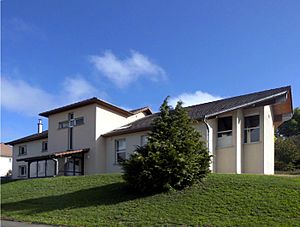

During the 1500s, Mennonites and other Anabaptists faced much hardship. This time of difficulty greatly shaped who Mennonites are. A book called Martyrs Mirror, published in 1660, tells many stories of the Anabaptists who suffered for their faith. This book is still very important to many Mennonites and Amish today.
In 1693, Jakob Ammann tried to make changes to the Mennonite church. He wanted to include practices like "shunning" (avoiding people who were excommunicated). When his ideas were not accepted, Ammann and his followers separated. They became known as the Amish. Over time, other groups also separated from the Amish. These new groups included the Old Order Amish and New Order Amish.
Rulers often welcomed Mennonites into their lands. This was because Mennonites were honest, hardworking, and peaceful. But sometimes, these rulers would change their minds. Or a new ruler would come to power. Then, Mennonites would have to leave again, often losing everything. But usually, another ruler in a different place would welcome them.
Mennonites in the Colonial America had more religious freedom. But in Europe, they continued to face challenges. They were sometimes invited to settle on poor land that no one else wanted to farm. Because they often had to give up their belongings, Mennonites learned to live very simply. This was seen in their homes and churches. Their clothes and buildings were plain. The music in church was often simple German songs sung without instruments. This simple style reminds many Mennonites of their history. Some Mennonite groups still live this "plain" lifestyle today.
How Many Mennonites Are There?
The Mennonite World Conference was started in 1925. This was to celebrate 400 years of Anabaptism. In 2022, this organization had 109 member groups in 59 countries. It had 1.47 million baptized members in 10,300 churches.
Mennonite Beliefs and Practices
Mennonites believe in the "Believers' Church." This means that people choose to join the church when they are old enough to understand and believe.
One of the first statements of Mennonite faith was the Schleitheim Confession. It was adopted on February 24, 1527. Its seven main points included:
- The Ban (removing members from the church)
- Communion (sharing bread and wine)
- Separation from worldly groups
- Believer's baptism (only for those who choose it)
- Pastors in the church
- Not using weapons or violence (Christian pacifism)
- Not swearing oaths (promises made to God)
The Dordrecht Confession of Faith was adopted in 1632. Many Mennonite groups have followed it for centuries. It says that when people hear about God's love, the Holy Spirit helps them accept salvation. This means God brings them into a right relationship without forcing them. People respond by trusting God, turning away from sin, and joining the church. They show their faith by obeying Christ. Baptism is a public way to show this commitment.
Traditionally, Mennonites tried to follow the beliefs of early Christians. They practiced the lovefeast (which includes footwashing and communion). They also practiced headcovering, nonresistance, sharing what they owned, and living simply. These practices are very important in Old Order Mennonite and Conservative Mennonite churches.
Seven important practices have been taught in many traditional Mennonite churches. These include "baptism, communion, footwashing, marriage, anointing with oil, the holy kiss, and the prayer covering."
Today, there are many different ways Mennonites worship and live. This section describes the main types of Mennonites, especially in North America.
Moderate Mennonites include the largest groups, like the Mennonite Brethren. Their worship and practices are similar to many other Protestant churches. They do not have special clothing rules. They also use modern technology. Worship services usually include singing, reading from the Bible, prayer, and a sermon. Some churches use hymns, while others use modern Christian music. Mennonite churches support themselves and choose their own ministers.
The main differences for moderate Mennonites are more about what they focus on. They emphasize peace, community, and helping others. Members live in the wider community. They try to be a positive influence. The main ideas of Menno Simons are still important, but in a more moderate way. For example, removing members from the church is rare. Serving in the military is generally not allowed. But working in law or law enforcement is fine. Helping people at home and around the world is encouraged. The Mennonite Central Committee (MCC) is a leader in providing aid.
Traditionally, very simple clothing was expected, especially in Conservative Mennonite groups. As more Mennonites moved to cities, this visible difference has mostly disappeared outside of conservative groups.
The Reformed Mennonite Church started in the early 1800s. They see themselves as true followers of Menno Simons's teachings. They use only the Bible as their guide. They live simply and wear traditional clothes. However, they allow their children to go to public schools and use cars.
The Church of God in Christ, Mennonite group started in 1859. They focus on personal conversion and strict church rules. They stay separate from other Mennonite groups. They discourage too much use of the Internet. They also avoid television, cameras, and radio. In 2013, this group had 24,400 baptized members.
Old Order Mennonites include several different groups. Some use horses and buggies for travel and speak German. Others drive cars and speak English. Most Old Order groups share conservative beliefs and traditions. They do not get involved in politics. They also avoid many things they call "sins of the world." Most Old Order groups send their children to Mennonite schools.
- Horse and Buggy Old Order Mennonites came from splits in the late 1800s. These splits happened when conservative Mennonites disagreed with new changes in worship. Most of these groups allow tractors for farming. But some insist on steel-wheeled tractors so they cannot be used on roads. Like the Stauffer Mennonites, they emphasize separating from the world and wearing plain clothes.
- Automobile Old Order Mennonites also came from the same splits. They started using cars in 1927. But the cars had to be plain and black. The largest group is still known as ""Black Bumper" Mennonites." This is because some members still paint their car bumpers black.
Stauffer Mennonites are one of the first and most conservative groups of Horse and Buggy Mennonites. They started in 1845. They emphasize strict separation from "the world." They limit cars and technology. They also wear plain clothing.
Conservative Mennonites generally wear somewhat traditional clothes. But they accept other technology. They are not one unified group. They are divided into many independent groups. Most Conservative Mennonite churches came from an Amish background, not a Mennonite one. They emerged from groups between the Old Order Amish and Amish Mennonites.
These groups drive cars, have phones, and use electricity. Some may have computers. They also have Sunday school and operate their own Christian schools. While moderate Mennonite groups have become smaller, Conservative Mennonite groups continue to grow.
Many Progressive Mennonite churches welcome all members. Some progressive Mennonite churches are part of moderate Mennonite groups. Others are independent churches. Most progressive Mennonite Churches focus on the Mennonite teachings of peace and non-violence.
Russian Mennonites
"Russian Mennonites" are descendants of Dutch Anabaptists. These Anabaptists settled near Danzig and in West Prussia around 1530. They lived there for about 250 years. Starting in 1791, they began to settle in the southern part of the Russian Empire. Later, they also settled in other Russian regions. Their special language is Plautdietsch. This is a German dialect with some Dutch words. Today, many traditional Russian Mennonites use Standard German in church.
In the 1770s, Catherine the Great of the Russian Empire gained a lot of land. This land was north of the Black Sea (in present-day Ukraine). Russian officials invited Mennonites from Prussia to farm this land. In return, they offered religious freedom and freedom from military service. Over the years, Mennonite farmers and businesses became very successful.
Between 1874 and 1880, about 16,000 Mennonites left Russia. About 9,000 went to the United States. About 7,000 went to Canada. In the 1920s, Russian Mennonites from Canada began to move to Latin America. This included Mexico and Paraguay. Later, more Mennonites from the Soviet Union also moved there. These migrations led to settlements in Peru, Brazil, Uruguay, Belize, Bolivia, and Argentina.
By the early 1900s, Mennonites in Russia owned large farms and businesses. After the Russian Revolution of 1917, they lost their farms and businesses. People who openly practiced religion were often imprisoned by the Soviet government. This led to many Mennonites moving to the Americas.
When the German army entered the Soviet Union in 1941, many Mennonites saw them as helpers. When the war changed, many Mennonites moved with the German army back to Germany. After the war, many Mennonites in the Soviet Union were forced to move to Siberia and Kazakhstan. Many were sent to labor camps. In the 1990s, the governments of Kazakhstan, Russia, and Ukraine allowed these people to move. Most of them moved to Germany.
Today, most Russian Mennonites and their descendants live in Latin America, Germany, and Canada. The most conservative Mennonites live in Belize. They do not use motors or paint.
Mennonites in North America

In the 1600s, Mennonites moved from the Netherlands to Germany to escape difficulties. William Penn invited some of these German Mennonites to settle in his new colony in America. The first permanent Mennonite settlement in America was in 1683. One Mennonite family and twelve Mennonite-Quaker families arrived from Germany. They settled in Germantown, Pennsylvania. Among them was William Rittenhouse, who owned the first American paper mill. Four of these early settlers signed the first formal protest against slavery in the United States in 1688.
In the early 1700s, many Germans from the Palatinate region moved to Pennsylvania. They became known as the Pennsylvania Dutch. About 2,500 of these immigrants were Mennonites and 500 were Amish. They settled in the Lancaster area. The oldest Mennonite meetinghouse in the United States is the Hans Herr House.
During Colonial America, Mennonites were different from other German settlers in three ways. They opposed the American Revolutionary War. They also resisted public education. And they did not approve of religious revivals. Mennonites contributed ideas like the separation of church and state and opposing slavery.
From 1812 to 1860, more Mennonites moved west to Ohio, Indiana, Illinois, and Missouri. These Swiss-German speaking Mennonites, along with Amish, came from Switzerland and Alsace-Lorraine.
Mennonite settlements also formed in Canada. These were from people who moved there from the United States.
According to a 2017 report, there are two main types of Mennonites in Canada. The "Swiss-South German Mennonites" came through Pennsylvania. The "Dutch-North German Mennonites" came through Russia (Ukraine). In the late 1700s and early 1800s, "Swiss" Mennonites settled in southern Ontario. In the 1870s, many "Russian" Mennonites moved to southern Manitoba. More "Russian" Mennonites came to Canada in the 1920s and 1940s. In recent years, Mennonites have also come to Canada from Mexico.
In the 1880s, smaller Mennonite groups settled as far west as California.
Old Order Mennonites and Amish are often confused. But a 2017 report explained that their customs are similar, but their cultural differences are important. Old Order Mennonites and Amish have the same European roots. They speak the same German dialect at home. Old Colony Mennonites speak a different German dialect called Low German.
Different Mennonite Groups in North America
"Old" Mennonite Church (MC)
The Swiss-German Mennonites who came to North America in the 1700s and 1800s formed the "Old Mennonite Church." This was the largest progressive Mennonite group. It merged with another group in 2002.
Mennonite Brethren Church
The Mennonite Brethren Church started among Russian Mennonites in 1860. It has churches in over 20 countries. In 2019, it had about 500,000 members.
Mennonite Church USA
The Mennonite Church USA (MCUSA) and the Mennonite Church Canada were formed in 2002. This happened when two large Mennonite groups merged. In 2001, the Mennonite Church USA had about 120,000 members. By May 2021, their website stated about 62,000 members.
Pennsylvania is still a main area for this group. But there are also many members in Ohio, Indiana, Kansas, and Illinois.
The merger of these two groups in 2002 helped fulfill a wish to unite all Mennonites. However, not all Mennonites supported the merger.
Mennonite Church Canada
Mennonite Church Canada is a group of Mennonites in Canada. Its main office is in Winnipeg, Manitoba. In 2003, it had about 35,000 members in 235 churches. It merged with the US group to form Mennonite Church USA and Mennonite Church Canada in 2000.
This group is divided into five regional conferences. Mennonite Church Canada works with other church groups in Canada and around the world.
Conservative Mennonites
Conservative Mennonites are groups that keep more traditional ways. They often wear conservative clothes. But they accept modern technology. They are not one single group. They are divided into many independent groups. Most Conservative Mennonite churches came from an Amish background.
These groups drive cars, have phones, and use electricity. Some may have personal computers. They also have Sunday school and run their own Christian schools. While moderate Mennonite groups have become smaller, Conservative Mennonite groups continue to grow.
In Ontario, Canada, about 20% of Mennonites are part of conservative groups.
Old Colony Mennonites
Old Colony Mennonites are conservative Mennonite groups. They are mostly German-speaking Russian Mennonites. They came from the Chortitza Colony in Russia. They are now common in Latin America and Canada. There are about 400,000 Russian Mennonites in the world. They are different from Old Order Mennonites, even though they have some similarities.
Old Order Mennonites
The Old Order Mennonites live a lifestyle similar to or a bit more modern than the Old Order Amish. In 2008/9, there were over 27,000 adult, baptized members of Old Order Mennonites in North America and Belize. The total population, including children, was roughly between 60,000 and 80,000.
Alternative Service During Wartime
During World War II, Mennonites who did not want to fight were given other options. They could serve in medical roles without fighting. Or they could work in parks and on roads under civilian control. Over 95% chose the latter. They worked in Alternative Service camps. They built roads, worked in forests, and fought fires. Later, they worked in farming and industry. The Mennonite Central Committee helped organize these camps.
These men worked without pay. Their churches and families supported them. They served longer than regular soldiers. Government agencies learned to appreciate their work. They made important contributions to preventing forest fires, controlling floods, and improving mental health care.
How Mennonite Groups Formed
Before moving to America, Anabaptists in Europe were divided. Some were from Dutch/North German areas. Others were from Swiss/South German areas. The Dutch/North German group first took their name from Menno Simons. Later, the Swiss/South German group also used the name "Mennonites." A third group, the Hutterites, formed in other parts of Europe. Most Swiss/South German Anabaptists now live in the US and Canada. Most Dutch/North German Anabaptists (Russian Mennonites) now live in Latin America.
A small number of North German Mennonites began moving to America in 1683. A much larger group of Swiss/South German Mennonites followed in 1707. The Amish separated from the Swiss/South German group in 1693. Over the years, many Amish individuals and churches rejoined Mennonite groups.
After coming to America, many early Mennonites separated from the main group. They formed their own churches. The first split in America happened in 1778. This was because Bishop Christian Funk supported the American Revolution. Other splits happened over the centuries. These divisions were due to disagreements about beliefs and church rules. Many modern churches came from groups that changed traditional Mennonite practices.
Larger groups of Dutch/North German Mennonites came to North America from the Russian Empire after 1873. They settled in places like Kansas and Manitoba. Some of these Mennonites became part of mainstream society. More conservative ones moved to Latin America. Since then, many Mennonites have moved from Latin America to North America.
These historical splits created the different Mennonite groups we see today.
Schools
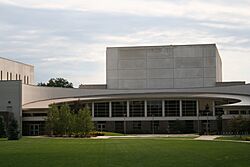
Several Mennonite groups have started their own schools, colleges, and seminaries. Conservative groups, like the Holdeman Mennonites, have their own schools. They also have their own teaching plans and teachers.
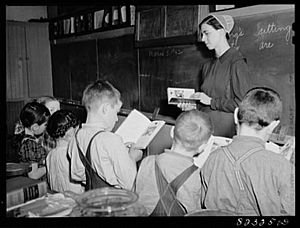
Ethnic Mennonites
Mennonites are a global religious group. They have members from many different backgrounds. But some Mennonite communities are descendants of people who moved from Switzerland and Russia. These groups are sometimes called "ethnic Mennonites."
Today, some people see Mennonites as a religious group with different ethnic members. Others see them as both an ethnic group and a religious group. There is discussion among Mennonites about this. Some say they are just a religious group. Others argue they are a distinct ethnic group. Historians and sociologists are increasingly seeing Mennonites as an "ethno-religious group."
Environmental Impacts

In Latin America, Mennonite settlements have sometimes led to environmental changes. This includes clearing land for farming in countries like Belize, Bolivia, Colombia, Mexico, Paraguay, and Peru. Indigenous people in Suriname have also expressed concerns. Since the early 1900s, Mennonite farming has changed large areas of wilderness. This includes parts of the Gran Chaco and the Amazon rainforest.
This has sometimes led to problems with indigenous peoples. The success of Mennonite farmers in growing crops like soybeans and raising cattle has inspired others. While the changes made by Mennonite colonies are smaller than those by very large companies, the environmental impact is being discussed. Sometimes, legal challenges are made.
The Monitoring of the Andean Amazon Project (MAAP) has found that Mennonite settlements are a new cause of deforestation in Bolivia and Peru. In Peru, MAAP found that over 7,000 hectares (about 27 square miles) of rainforest were lost between 2017 and 2023 after Mennonite settlers arrived.
On the Yucatán Peninsula in Mexico, farming by Mennonites has led to the clearing of native tropical rainforest. In July 2018, Mexican Mennonites were fined for cutting down trees without permission on 1,445 hectares (about 5½ square miles) of shared land.
Service Projects
The Mennonite Disaster Service is a group of volunteers from Anabaptist churches. They help people after hurricanes, floods, and other disasters in the U.S. and Canada. They provide both immediate and long-term help.
Mennonite Central Committee (MCC) was founded on September 27, 1920. It provides disaster relief around the world. It also has long-term development programs. In 1972, Mennonites in Altona, Manitoba, started MCC Thrift Shops. These shops have grown and now help people in need worldwide.
Since the late 1900s, some Mennonite groups have become more involved in peace and social justice. They helped start groups like Christian Peacemaker Teams.
Membership
According to a 2018 count by the Mennonite World Conference (MWC), it has 107 member groups in 58 countries. It had 1.47 million baptized members. In 2023, their membership included 108 groups from 60 countries. There were around 1.45 million baptized members in over 10,180 churches. As of 2023, most members (84%) were from Africa, Asia, or Latin America. Only 16% were from Europe and North America.
Africa has the fastest growth in membership. It increases by 10% to 12% each year. This is especially true in Ethiopia due to new conversions. African Mennonite churches grew a lot in the 1980s and 1990s. They attracted thousands of new members in Tanzania, Kenya, and the Congo. In recognition of this growth, the Mennonite World Conference held its meeting in Bulawayo, Zimbabwe, in 2003.
In Latin America, growth is strong because traditional Mennonites have high birth rates. Membership growth in North America, Asia/Pacific, and the Caribbean has also been steady. Europe has seen a slow decrease in Mennonite membership since about 1980.
How Mennonites Are Organized Worldwide
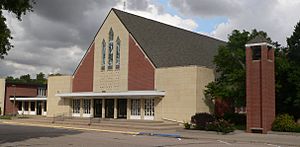
The most basic unit among Mennonites is the local church. There are hundreds or thousands of Mennonite churches and groups. Many are separate from each other. Some churches belong to regional groups. And some regional groups are part of larger national or international groups. There is no single world leader for all Mennonites. However, there is a Mennonite World Committee (MWC). It includes Mennonites from 60 countries. The MWC helps coordinate Mennonite efforts.
Most Mennonite churches are independent. They vary greatly in worship, church rules, and lifestyles. There is no central authority that speaks for all Mennonites. Over time, the cultural differences between Mennonite groups have become less noticeable.
The largest Mennonite/Anabaptist groups include:
- Mennonite Brethren (426,581 members in 2010 worldwide)
- Old Order Amish (383,565 members in 2023 worldwide)
- Meserete Kristos Church in Ethiopia (295,500 members in 2017)
- Old Colony Mennonite Church (120,000 in the U.S., Canada, Mexico, Bolivia, Paraguay, Belize and Argentina)
- Communauté Mennonite au Congo (86,600 members)
- Old Order Mennonites (60,000 to 80,000 members in the U.S., Canada and Belize)
- Mennonite Church USA (about 62,000 members in the United States)
- Kanisa La Mennonite Tanzania (50,000 members)
- Conservative Mennonites (30,000 members in over 500 U.S. churches)
- Mennonite Church Canada (26,000 members in 2018)
- Church of God in Christ, Mennonite (24,400 members)
Organization in North America
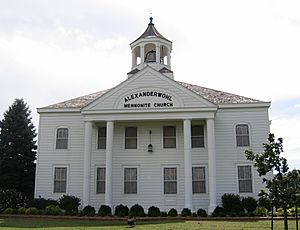

In 2015, there were 538,839 baptized members in 41 groups in the United States. The largest group was the Old Order Amish. In 2001, there were 80,820 Old Order Amish church members in the United States. The U.S. Conference of Mennonite Brethren Churches has 34,500 members. Another 27,000 are part of the Old Order Mennonites. The Mennonite Church USA has 78,892 members. Membership in the Mennonite Church USA has been decreasing.
Canada had 143,720 Mennonites in 16 groups in 2015. The Canadian Conference of Mennonite Brethren Churches had 37,508 baptized members. The Mennonite Church Canada had 31,000 members.
As of 2012, there were about 100,000 Old Colony Mennonites in Mexico. These Mennonites came from Canada in the 1920s. The Mexican government promised them freedom. This led to the first Old Colony settlements in Mexico.
Organization in Europe
Germany has the largest number of Mennonites in Europe. In 2015, the Mennonite World Conference counted 47,202 baptized members in 7 groups. The largest group is the Bruderschaft der Christengemeinde in Deutschland (Mennonite Brethren). It had 20,000 members in 2010. Another group is the Union of German Mennonite Congregations. It has 27 churches with 5,724 members. Over 40,000 Mennonites moved from Russia to Germany starting in the 1970s.
The Mennonite presence in the Netherlands is called Algemene Doopsgezinde Societeit. They have a seminary and organize relief and mission work. They have 121 churches with 10,200 members.
Switzerland had 1800 Mennonites in 14 churches in 2015. In 2015, there were 2078 Mennonites in France. France's 32 independent Mennonite churches have formed an association.
Ukraine once had many thousands of Mennonites. But in 2015, the number was only 499. They are organized into three groups.
The U.K. had 326 members in two groups in 2015. There is also a charity called The Mennonite Trust. It helps people understand Mennonite beliefs.
See also
 In Spanish: Menonita para niños
In Spanish: Menonita para niños
- Bible Mennonite Fellowship
- Bruderhof Communities
- Church of God in Christ, Mennonite
- Eastern Mennonite Missions
- List of Mennonites
- Mennonite Church USA Archives
- Mennonite cuisine
- Mennonite denominations
- Mennonites in Argentina
- Mennonites in Belize
- Mennonites in Bolivia
- Mennonites in Mexico
- Mennonites in Paraguay
- Mennonites in Russia
- Mennonites in Uruguay
- Mennonite literature
- Mennonite settlements of Altai
- Simple living
- Virginia Mennonite Missions


